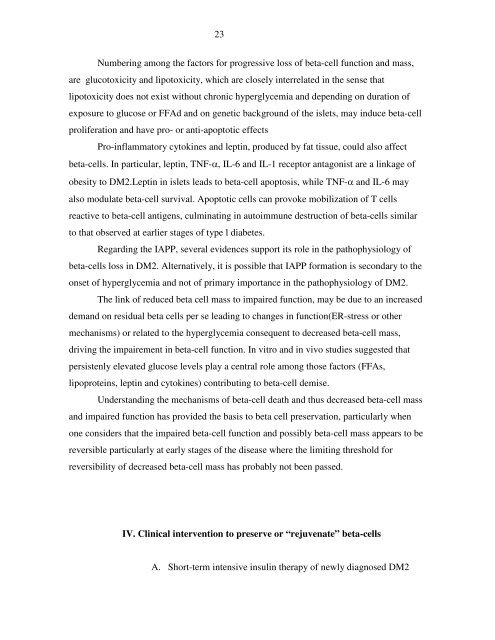1 BETA-CELL FAILURE IN DIABETES AND PRESERVATION BY ...
1 BETA-CELL FAILURE IN DIABETES AND PRESERVATION BY ...
1 BETA-CELL FAILURE IN DIABETES AND PRESERVATION BY ...
Create successful ePaper yourself
Turn your PDF publications into a flip-book with our unique Google optimized e-Paper software.
23<br />
Numbering among the factors for progressive loss of beta-cell function and mass,<br />
are glucotoxicity and lipotoxicity, which are closely interrelated in the sense that<br />
lipotoxicity does not exist without chronic hyperglycemia and depending on duration of<br />
exposure to glucose or FFAd and on genetic background of the islets, may induce beta-cell<br />
proliferation and have pro- or anti-apoptotic effects<br />
Pro-inflammatory cytokines and leptin, produced by fat tissue, could also affect<br />
beta-cells. In particular, leptin, TNF-α, IL-6 and IL-1 receptor antagonist are a linkage of<br />
obesity to DM2.Leptin in islets leads to beta-cell apoptosis, while TNF-α and IL-6 may<br />
also modulate beta-cell survival. Apoptotic cells can provoke mobilization of T cells<br />
reactive to beta-cell antigens, culminating in autoimmune destruction of beta-cells similar<br />
to that observed at earlier stages of type l diabetes.<br />
Regarding the IAPP, several evidences support its role in the pathophysiology of<br />
beta-cells loss in DM2. Alternatively, it is possible that IAPP formation is secondary to the<br />
onset of hyperglycemia and not of primary importance in the pathophysiology of DM2.<br />
The link of reduced beta cell mass to impaired function, may be due to an increased<br />
demand on residual beta cells per se leading to changes in function(ER-stress or other<br />
mechanisms) or related to the hyperglycemia consequent to decreased beta-cell mass,<br />
driving the impairement in beta-cell function. In vitro and in vivo studies suggested that<br />
persistenly elevated glucose levels play a central role among those factors (FFAs,<br />
lipoproteins, leptin and cytokines) contributing to beta-cell demise.<br />
Understanding the mechanisms of beta-cell death and thus decreased beta-cell mass<br />
and impaired function has provided the basis to beta cell preservation, particularly when<br />
one considers that the impaired beta-cell function and possibly beta-cell mass appears to be<br />
reversible particularly at early stages of the disease where the limiting threshold for<br />
reversibility of decreased beta-cell mass has probably not been passed.<br />
IV. Clinical intervention to preserve or “rejuvenate” beta-cells<br />
A. Short-term intensive insulin therapy of newly diagnosed DM2











